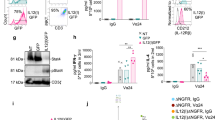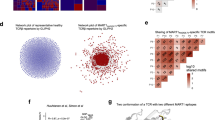Abstract
We have previously demonstrated that expansion of activated tumor-sensitized T cells in interleukin (IL)-7/15 results in greater expansion and antitumor activity than expansion in IL-2. We sought to determine whether T cells exposed to IL-2 versus IL-7/15 exhibited distinct gene expression patterns. Lymphocytes were harvested from Pmel-1 mice immunized with B16-GMCSF melanoma cells, activated in vitro, and cultured in IL-2 or IL-7/15 for 1, 3 or 6 days. T cells were harvested and analyzed using microarray, real-time quantitative polymerase chain reaction (RT-QPCR) or sorted into T-cell subsets and analyzed. We found significant differences in gene expression for T cells cultured in IL-2 versus IL-7/15, starting on day 3. This was not a function of subset differentiation; when T cells were divided into subsets, the central memory (TCM), effector memory (TEM) and effector (TE) T cells cultured in the IL-2 more closely resembled each other than the identical phenotypic subset exposed to IL-7/15. Thus, the differences in gene expression induced by culture in IL-2 versus IL-7/15 do not merely reflect differences in the frequency of TCM versus TEM versus TE cells, but rather reflect that the gene expression levels of those T-cell subsets when exposed to different cytokines are fundamentally different.
This is a preview of subscription content, access via your institution
Access options
Subscribe to this journal
Receive 12 print issues and online access
$259.00 per year
only $21.58 per issue
Buy this article
- Purchase on Springer Link
- Instant access to full article PDF
Prices may be subject to local taxes which are calculated during checkout






Similar content being viewed by others
References
Bear HD, Roberts J, Cornell D, Tombes MB, Kyle B . Adoptive immunotherapy of cancer with pharmacologically activated lymph node lymphocytes: a pilot clinical trial. Cancer Immunol Immunother 2001; 50: 269–274.
Klebanoff CA, Gattinoni L, Palmer DC, Muranski P, Ji Y, Hinrichs CS et al. Determinants of successful CD8+ T-cell adoptive immunotherapy for large established tumors in mice. Clin Cancer Res 2011; 17: 5343–5352.
Liu S, Riley J, Rosenberg S, Parkhurst M . Comparison of common gamma-chain cytokines, interleukin-2, interleukin-7, and interleukin-15 for the in vitro generation of human tumor-reactive T lymphocytes for adoptive cell transfer therapy. J Immunother 2006; 29: 284–293.
Le HK, Graham L, Miller CH, Kmieciak M, Manjili MH, Bear HD . Incubation of antigen-sensitized T lymphocytes activated with bryostatin 1+ionomycin in IL-7+IL-15 increases yield of cells capable of inducing regression of melanoma metastases compared to culture in IL-2. Cancer Immunol Immunother 2009; 58: 1565–1576.
Cha E, Graham L, Manjili MH, Bear HD . IL-7+IL-15 are superior to IL-2 for the ex vivo expansion of 4T1 mammary carcinoma-specific T cells with greater efficacy against tumors in vivo. Breast Cancer Res Treat 2010; 122: 359–369.
Payne KK, Zoon CK, Wan W, Marlar K, Keim RC, Kenari MN et al. Peripheral blood mononuclear cells of patients with breast cancer can be reprogrammed to enhance anti-HER-2/neu reactivity and overcome myeloid-derived suppressor cells. Breast Cancer Res Treat 2013; 142: 45–57.
Dumur CI, Nasim S, Best AM, Archer KJ, Ladd AC, Mas VR et al. Evaluation of quality-control criteria for microarray gene expression analysis. Clin Chem 2004; 50: 1994–2002.
Livak KJ, Schmittgen TD . Analysis of relative gene expression data using real-time quantitative PCR and the 2(-Delta Delta C(T)) Method. Methods 2001; 25: 402–408.
Irizarry RA, Bolstad BM, Collin F, Cope LM, Hobbs B, Speed TP . Summaries of Affymetrix GeneChip probe level data. Nucleic Acids Res 2003; 31: e15.
Storey JD . A direct approach to false discovery rates. J R Stat Soc Ser B Stat Methodol 2002a; 64: 479–498.
Yang S, Gattinoni L, Liu F, Ji Y, Yu Z, Restifo NP et al. In vitro generated anti-tumor T lymphocytes exhibit distinct subsets mimicking in vivo antigen-experienced cells. Cancer Immunol Immunother 2011; 60: 739–749.
Willinger T, Freeman T, Hasegawa H, McMichael AJ, Callan MF . Molecular signatures distinguish human central memory from effector memory CD8 T cell subsets. J Immunol 2005; 175: 5895–5903.
Lin CG, Leu SJ, Chen N, Tebeau CM, Lin SX, Yeung CY et al. CCN3 (NOV) is a novel angiogenic regulator of the CCN protein family. J Biol Chem 2003; 278: 24200–24208.
Lin CG, Chen CC, Leu SJ, Grzeszkiewicz TM, Lau LF . Integrin-dependent functions of the angiogenic inducer NOV (CCN3): implication in wound healing. J Biol Chem 2005; 280: 8229–8237.
Sakamoto K, Yamaguchi S, Ando R, Miyawaki A, Kabasawa Y, Takagi M et al. The nephroblastoma overexpressed gene (NOV/ccn3) protein associates with Notch1 extracellular domain and inhibits myoblast differentiation via Notch signaling pathway. J Biol Chem 2002; 277: 29399–29405.
Perbal B, Martinerie C, Sainson R, Werner M, He B, Roizman B . The C-terminal domain of the regulatory protein NOVH is sufficient to promote interaction with fibulin 1C: a clue for a role of NOVH in cell-adhesion signaling. Proc Natl Acad Sci USA 1999; 96: 869–874.
Ellis PD, Metcalfe JC, Hyvonen M, Kemp PR . Adhesion of endothelial cells to NOV is mediated by the integrins alphavbeta3 and alpha5beta1. J Vasc Res 2003; 40: 234–243.
Benini S, Perbal B, Zambelli D, Colombo MP, Manara MC, Serra M et al. In Ewing's sarcoma CCN3(NOV) inhibits proliferation while promoting migration and invasion of the same cell type. Oncogene 2005; 24: 4349–4361.
Perbal B, Lazar N, Zambelli D, Lopez-Guerrero JA, Llombart-Bosch A, Scotlandi K et al. Prognostic relevance of CCN3 in Ewing sarcoma. Hum Pathol 2009; 40: 1479–1486.
Vallacchi V, Daniotti M, Ratti F, Di Stasi D, Deho P, De Filippo A et al. CCN3/nephroblastoma overexpressed matricellular protein regulates integrin expression, adhesion, and dissemination in melanoma. Cancer Res 2008; 68: 715–723.
Zaballos A, Gutierrez J, Varona R, Ardavin C, Marquez G . Cutting edge: identification of the orphan chemokine receptor GPR-9-6 as CCR9, the receptor for the chemokine TECK. J Immunol 1999; 162: 5671–5675.
Crellin NK, Garcia RV, Hadisfar O, Allan SE, Steiner TS, Levings MK . Human CD4+ T cells express TLR5 and its ligand flagellin enhances the suppressive capacity and expression of FOXP3 in CD4+CD25+ T regulatory cells. J Immunol 2005; 175: 8051–8059.
Acknowledgements
We gratefully acknowledge the support of VCU Massey Cancer Center, the Women and Wellness Fund and the VCU Massey Cancer Center Flow Cytometry Shared Resource, supported, in part, with funding from NIH-NCI Cancer Center Support Grant P30 CA016059.
Author information
Authors and Affiliations
Corresponding author
Ethics declarations
Competing interests
The authors declare no conflict of interest.
Rights and permissions
About this article
Cite this article
Zoon, C., Seitelman, E., Keller, S. et al. Expansion of melanoma-specific lymphocytes in alternate gamma chain cytokines: gene expression variances between T cells and T-cell subsets exposed to IL-2 versus IL-7/15. Cancer Gene Ther 21, 441–447 (2014). https://doi.org/10.1038/cgt.2014.48
Received:
Revised:
Accepted:
Published:
Issue Date:
DOI: https://doi.org/10.1038/cgt.2014.48
This article is cited by
-
Murine myeloid derived suppressor cells possess a range of suppressive mechanisms—Granzyme B is not among them
Cancer Immunology, Immunotherapy (2022)
-
Co-transfer of tumor-specific effector and memory CD8+ T cells enhances the efficacy of adoptive melanoma immunotherapy in a mouse model
Journal for ImmunoTherapy of Cancer (2018)
-
Enhanced local and systemic anti-melanoma CD8+ T cell responses after memory T cell-based adoptive immunotherapy in mice
Cancer Immunology, Immunotherapy (2016)



